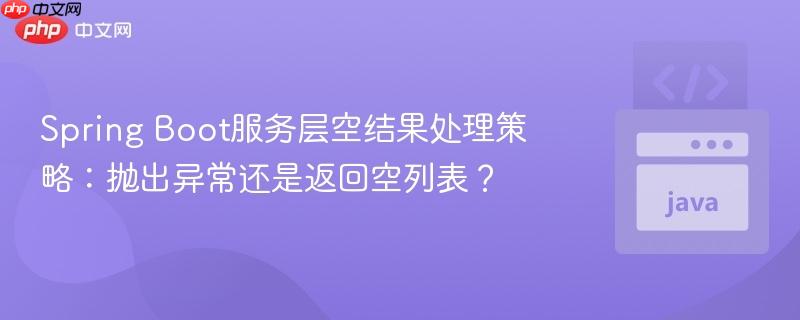
在spring boot应用中,当数据查询未返回任何结果时,服务层应选择抛出`entitynotfoundexception`并返回404状态码,还是直接返回一个空列表并保持200状态码?本文将深入探讨这两种策略的适用场景、实现方式、优缺点及决策考量,旨在帮助开发者根据具体业务需求和api语义,做出最合适的选择。
在构建RESTful API时,如何优雅且语义明确地处理数据查询的空结果是一个常见的设计问题。这通常涉及到两种主要策略:将空结果视为一种异常情况并抛出异常,或者将其视为一种正常的、但结果为空的响应。这两种方法各有其适用场景和优缺点。
当查询结果为空被认为是“资源不存在”的异常情况时,抛出 EntityNotFoundException 并由全局异常处理器捕获,然后返回 HTTP 404 Not Found 状态码是一种常见的做法。这种策略通常适用于按唯一标识符(如ID)查询单个资源,或在特定业务逻辑下,空结果被视为请求失败的情况。
服务层逻辑: 在服务方法中,检查从数据仓库返回的列表是否为空。如果为空,则抛出 EntityNotFoundException。
import javax.persistence.EntityNotFoundException; // 或自定义异常
public class EmployeeService {
private EmployeeRepository employeeRepo; // 假设已注入
public List<Employee> findEmployeesByName(String name) {
List<Employee> employees = employeeRepo.findByName(name);
// 如果根据名称查询,业务上认为找不到任何员工是一种异常情况
if (employees.isEmpty()) {
throw new EntityNotFoundException("未找到任何名为 '" + name + "' 的员工。");
}
return employees;
}
public Employee findEmployeeById(Long id) {
return employeeRepo.findById(id)
.orElseThrow(() -> new EntityNotFoundException("未找到ID为 '" + id + "' 的员工。"));
}
}全局异常处理器: 使用 @RestControllerAdvice 定义一个全局异常处理器,捕获 EntityNotFoundException 并将其映射到 HTTP 404 Not Found 状态码。
import lombok.extern.slf4j.Slf4j;
import org.springframework.http.HttpStatus;
import org.springframework.http.ResponseEntity;
import org.springframework.web.bind.annotation.ExceptionHandler;
import org.springframework.web.bind.annotation.ResponseStatus;
import org.springframework.web.bind.annotation.RestControllerAdvice;
import org.springframework.web.context.request.WebRequest;
import javax.persistence.EntityNotFoundException; // 确保与服务层抛出的异常一致
@Slf4j
@RestControllerAdvice
public class GlobalExceptionHandler {
// 假设有一个简单的ErrorResponse类
public static class ErrorResponse {
private int status;
private String message;
public ErrorResponse(int status, String message) {
this.status = status;
this.message = message;
}
public int getStatus() { return status; }
public void setStatus(int status) { this.status = status; }
public String getMessage() { return message; }
public void setMessage(String message) { this.message = message; }
}
@ExceptionHandler(EntityNotFoundException.class)
@ResponseStatus(HttpStatus.NOT_FOUND)
public ResponseEntity<Object> handleEntityNotFoundException(EntityNotFoundException ex,
WebRequest request) {
log.error("实体未找到异常:{}", ex.getMessage());
// 构建统一的错误响应体
ErrorResponse errorResponse = new ErrorResponse(HttpStatus.NOT_FOUND.value(), ex.getMessage());
return ResponseEntity.status(HttpStatus.NOT_FOUND).body(errorResponse);
}
// 其他异常处理方法...
}当查询结果为空被视为一种正常、非异常的业务结果时,直接返回一个空列表(或空集合)并保持 HTTP 200 OK 状态码是更合适的选择。这种策略通常适用于搜索、过滤或获取集合资源的操作,其中“没有匹配项”本身就是一种有效的查询结果。
服务层逻辑: 服务方法直接返回从数据仓库获取的列表,不做额外判断。
// EmployeeService.java
public class EmployeeService {
private EmployeeRepository employeeRepo; // 假设已注入
public List<Employee> findEmployeesByName(String name) {
// 直接返回查询结果,即使为空
return employeeRepo.findByName(name);
}
}控制器层和客户端: 控制器直接返回服务层的空列表。客户端负责检查返回的列表是否为空,并据此更新UI或执行后续逻辑。
// EmployeeController.java
import org.springframework.web.bind.annotation.GetMapping;
import org.springframework.web.bind.annotation.RequestParam;
import org.springframework.web.bind.annotation.RestController;
import java.util.List;
@RestController
public class EmployeeController {
private EmployeeService employeeService; // 假设已注入
@GetMapping("/employees")
public List<Employee> getEmployeesByName(@RequestParam(required = false) String name) {
if (name != null && !name.isEmpty()) {
return employeeService.findEmployeesByName(name);
}
// 如果没有提供名称,可能返回所有员工或空列表
return employeeService.findAllEmployees(); // 假设有此方法
}
}在决定抛出异常还是返回空列表时,应综合考虑以下因素:
API语义与RESTful原则:
业务含义:
客户端预期:
一致性:
没有一劳永逸的解决方案。最佳实践取决于具体的业务场景和API设计目标。
在实际开发中,开发者应与产品经理和前端团队充分沟通,明确API的预期行为和错误处理策略,以确保构建出易于理解和使用的API。
以上就是Spring Boot服务层空结果处理策略:抛出异常还是返回空列表?的详细内容,更多请关注php中文网其它相关文章!

每个人都需要一台速度更快、更稳定的 PC。随着时间的推移,垃圾文件、旧注册表数据和不必要的后台进程会占用资源并降低性能。幸运的是,许多工具可以让 Windows 保持平稳运行。

Copyright 2014-2025 https://www.php.cn/ All Rights Reserved | php.cn | 湘ICP备2023035733号